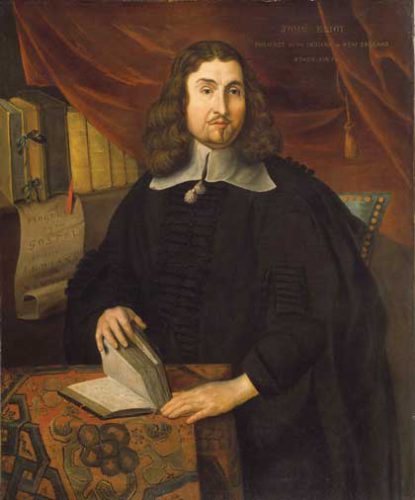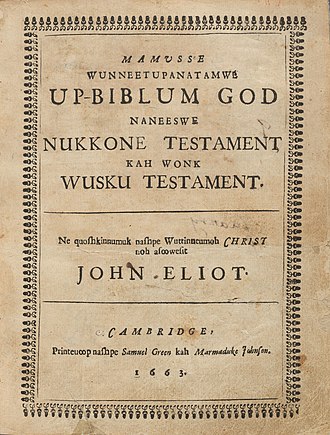What is an ‘Indian praying town’ and who was John Eliot?
By Elizabeth Prata

When I was researching for my series on Puritan Wives entry on Margaret Winthrop, I read this in a footnote and followed it up to the source. “In 1640, Margaret Winthrop was deeded 3,000 acres of land at the mouth of the Concord River, which was later sold for establishing Wamesit, an Indian Praying Town.” Source
Wait, wut?! An Indian Praying Town? I need to know more about this please. It all starts with Puritan John Eliot.
“Eliot left England, the land of his birth, in 1631 as a young Puritan pastor. He worked in Boston for a year, then established a church five miles away in Roxbury, where he remained for 58 years, until his death. From the beginning he established an excellent relationship with the Narragansett Indians in the area and gradually also with other peoples speaking related languages.” Source
It seems that shortly after settling in Massachusetts, the Puritans recognized the need to evangelize the Native Americans. The language barrier was a difficulty, though. John Eliot was particularly burdened for these souls, and attempted a sermon in 1646 which was a failure, mainly due to the butchered language. Nevertheless, Eliot continued to meet with the leader (sachem) of the Massachusetts tribe, Cutshamekin, and soon he converted.
But the language barrier bothered Eliot, and he decided to do something about it. The Pequot Cockenoe, who had been captured in the 1637 Pequot War between the colonists and the Indians, served Eliot as translator and teacher. In return, Eliot taught Cockenoe how to write. The first things Eliot transliterated was the Lord’s Prayer and the Ten Commandments, plus some other prayers. By the late 1640s, Eliot was preaching to the Indians in their language. The earliest converts were from Eliot having conducted sermons and visited Native American homes, these were the earliest ways of propagating the gospel. But it was slow and cumbersome, and there was only one of Eliot.
Eliot wrote to England for help. In 1649, the government in England chartered the “Corporation for the Promoting and Propagating the Gospel of Jesus Christ in New England”. The Act endowed the parties with an official Corporation, complete with President and Treasurer. It was allowed to collect and send money to the Puritans in New England for the purpose of missions to the indigenous peoples on this side of the Atlantic. They raised 12,000 English pounds! That is equivalent to 2million dollars in today’s currency (according to one history calculator).
As converts increased, Eliot then set about finding acreage for these newly converted Indians to live, called “praying Indians”. He wanted to separate them from their tribal obligations and mode of dress, and reduce temptations. He also wanted to have the Native Americans and Colonists mix more.
This is where the acreage mentioned at the top of this essay comes in. The Winthrop acreage established an “Indian Praying Town”. It was and to this day is called Natick, Massachusetts. Eliot taught them how to establish a Christian community.
Eliot then ramped up his commitment to translate the Bible into their language, Algonquin. No easy task, there was no Algonquian alphabet! Eliot had to devise one, and thus became a lexicographer and grammarian in their language. He spent the next 14 years doing this but eventually in 1663, published “Mamusse Wunneetupanatamwe Up-Biblum God”.

Three years later, The Indian Grammar Begun was published also.
Now that it was translated, the Bible needed to be printed. Eliot wrote to the Corporation-
“I shall not trouble you with anything at present save this one business of moment, the printing of the Bible in the Indian language, which business sundry of the elders did petition unto the Commissioners, moving them to further it, as a principal means of promoting religion among them. … [Please send a printer] to New-England at the press in Harvard College, and work under the College printer, in impressing the Bible in the Indian language and with him send a convenient stock of paper“. (Source- The early Massachusetts press, 1638-1711, by George Emery Littlefield)
And the Corporation did just that, sending professional printer Marmaduke Johnson, 100 reams of paper, and 80 pounds of new type for the printer.
“Eliot was the only missionary to devise a new alphabet from an unwritten language for the purpose of teaching and preaching the scriptures“, we read in American Puritans by Benge and Pickowicz. Eliot helped found the first missionary society in the New World, printed the first Bible in the New World, and was known as ‘Apostle to the Indians.’
Meanwhile, the “Indian Praying Towns” were multiplying. Eliot’s son John Jr. was now helping, then his son-in-law came to serve as well. There were 14 Indian Praying Towns in Massachusetts and 3 in Connecticut at the height. Eliot also established schools for the Christian Indians, established churches, and encouraged commerce between the Natives and the Puritan colonists. All was going well until…

King Philips War ended things abruptly. King Philip was actually a Native American called Metacom who started a war in 1675 until 1676 between a group of Indians and the English Colonists & their Native allies. Metacom’s father was Massasoit, you may remember, the Native American who helped the earliest Pilgrims who landed at Plymouth. Massasoit helped them avoid starvation. After Massasoit passed away, Metacom was not as friendly, claiming violations of the English in the treaties, and encouraged raiding parties. Eventually as tensions increased, war broke out.
Praying Indians offered to aid the Colonists in this war but were rejected. Many were either confined to their towns or relocated to Deer Isle. When the war was concluded relations among any and all Native Americans’ including the Praying Indians, was permanently damaged. It was said that it was a violation to even speak well of an Indian.
In 1675, when Philip’s war broke out, the English inhabitants generally were jealous of the praying Indians, and would have destroyed them, had not General Gookin and Mr Eliot stepped forth in their defence. Source, “History of the town of Natick, Mass. : from the days of the apostolic Eliot, MDCL, to the present time” by William Bigelow, 1830.
Things never got back to the height of the well-thought-of Praying Town. Ten of the original fourteen MA towns were disbanded. A few stragglers filtered back to Natick, the original Praying Indian Town, but it was closely supervised by the colonists.

John Eliot poured out his life for the Native Americans in his sphere. He was earnest for these souls and in return was beloved by the people he helped convert. Tokkohwompait was one of these men. At the end of Eliot’s life, he wrote to John Eliot,
“God hath made you to us and our nation a spiritual father, we are inexpressibly engaged to you for your faithful indefatigable labors, and love, to us and for us, you have always manifested the same to us as well in our adversity or prosperity, for about forty years making known to us the glad tidings of salvation of Jesus Christ.”
What a testimony for the name of Jesus Christ. What a well-done life poured out on behalf of pagan souls. Many do not know of John Eliot’s missionary endeavors, but I encourage you to search further and read up on this inspiring man.
Sources:
Book- The American Puritans by Dustin Benge and Nate Pickowicz
Wikipedia Indian Praying Towns
Native Northeast Portal: John Eliot
Native Northeast Portal: Margaret Tyndal Winthrop
The early Massachusetts press, 1638-1711, by George Emery Littlefield






